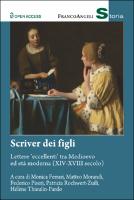Scriver dei figli
Lettere ‘eccellenti’ tra Medioevo ed età moderna (XIV-XVIII secolo)
| dc.contributor.editor | Ferrari, Monica | |
| dc.contributor.editor | Morandi, Matteo | |
| dc.contributor.editor | Piseri, Federico | |
| dc.contributor.editor | Rochwert-Zuili, Patricia | |
| dc.contributor.editor | Thieulin-Pardo, Hélène | |
| dc.date.accessioned | 2022-03-28T15:31:55Z | |
| dc.date.available | 2022-03-28T15:31:55Z | |
| dc.date.issued | 2021 | |
| dc.identifier | ONIX_20220328_9788835132769_14 | |
| dc.identifier | OCN: 1313556577 | |
| dc.identifier.uri | https://library.oapen.org/handle/20.500.12657/53633 | |
| dc.language | Italian | |
| dc.relation.ispartofseries | Storia/Studi e ricerche | |
| dc.subject.classification | thema EDItEUR::J Society and Social Sciences::JN Education::JNB History of education | en_US |
| dc.subject.classification | thema EDItEUR::Y Children’s, Teenage and Educational::YP Educational material::YPJ Educational: Humanities and social sciences, general::YPJH Educational: History | en_US |
| dc.subject.other | History of education, Europe XIV-XVIII centuries | |
| dc.subject.other | History of childhood, Europe XIV-XVIII centuries | |
| dc.subject.other | History of the family, Europe XIV-XVIII centuries | |
| dc.subject.other | Epistolary exchanges | |
| dc.subject.other | Educational strategies during the Ancien Régime | |
| dc.subject.other | Pedagogical practices for the élites | |
| dc.subject.other | Educational devices in the court society | |
| dc.subject.other | The ages of life and the construction of social roles | |
| dc.subject.other | Epistolary novels | |
| dc.subject.other | History of educational historiography | |
| dc.title | Scriver dei figli | |
| dc.title.alternative | Lettere ‘eccellenti’ tra Medioevo ed età moderna (XIV-XVIII secolo) | |
| dc.type | book | |
| oapen.abstract.otherlanguage | Starting from the end of the Middle Ages and throughout the early modern era, there was a vast diffusion of the letter form, developed in the chancelleries of European courts and among elites according to canons that blended the rhetoric and chancery tradition with humanistic knowledge. The epistolary style suits the transmission of information and political decisions as well as a frequent exchange of everyday life news, revealing, at both public and private levels, a web of interpersonal relationships and, along with it, evidence of feelings that create ‘emotional communities’ to which, in many of the cases examined here, individuals looking for social recognition belong. | |
| oapen.relation.isPublishedBy | e2ddfb5e-9202-4851-8afe-1e09b020b018 | |
| oapen.relation.isbn | 9788835132769 | |
| oapen.pages | 361 | |
| oapen.place.publication | Milan |

